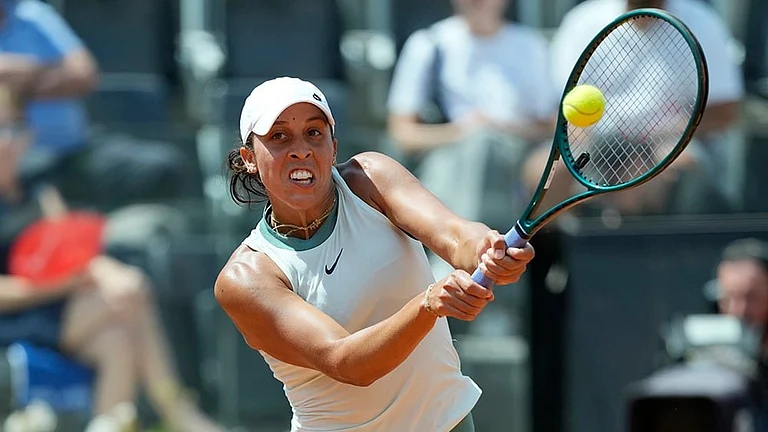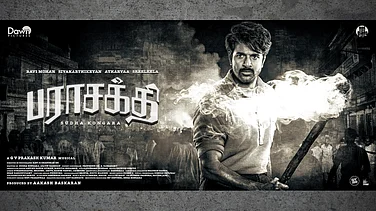IF auction houses like Sothebys and Bonhams are now casting their eyes on art from Pakistan, its no surprise. Running the full gamut from modernism to installation art, the exhibition Pakistan: Another Vision at Londons Brunei Gallery affords a rare glimpse into the inner ferment and defiant ebullience of Pakistani society today.
The large and ambitious show, curated by Timothy Wilcox and organised by Asia House and the Arts & the Islamic World journal, will travel to various galleries in the UK till November 8. The 100 works-from 1950 to the present-delineate the enormous distance Pakistani arts traversed. The works of Abdur Rahman Chughtai, who began painting much before Independence, were seen as a foundation for much that came later. But even in 1955, his watercolours like An Eastern Princess or A Poet with Songbirds didnt even remotely address the new nations tumultuous reality. As against this, the recent works of Akram Dost (born 1958) have tormented figures in nude or couple, capturing the anguish and isolation of women.
Modernism came to Pakistani art with painter Shakir Ali, who after training at Bombays J.J. School and a stint with Andre Lhote in Paris, joined Lahores Mayo School, founded by Rudyards father Lockwood Kipling in 1875. The school concentrated on the development of crafts till it was converted to the National College of Art in 58, and fine art was introduced. Its first director, American sculptor Mark Sponnenberg, encouraged the international modernist approach. Simultaneously, UK-trained Anna Molka, who set up the fine art department at Punjab university, promoted academic naturalism. The two trends co-exist even today.
"Contemporary art in Pakistan is a requiem of discontent," says Salim Asif, deputy editor of Jang. Its also an art thats crossed cultural and regional boundaries to confront that societys rigidities. As Karachi artist Samina Mansuri says of her work: "The boundaries are open and fluid, they speak the in-between and the ambiguous. These are dysfunctional characters, barely holding it together or in a general state of splitting or falling apart." But the human spirit endures. At the centre of her Raging Eye (1993), made entirely in earth colours, theres a volcanic outburst of burnt terracotta, like a nuclear holocaust. But on top are two hand imprints, possibly a womans, which denote a human presence that cant be wiped out.
If under General Zia calligraphic art was encouraged and all other forms virtually went underground, the figure now appears to have surfaced with a vengeance. In whichever form its revealed, the works subversive, exposing the underbelly of daily life.
Interestingly, Hindu imagery is now being used by Pakistani artists not only to signify religious intolerance (A.R. Nagoris Legacy and Holy Beast) but also to reveal the other. Anwar Saeeds He Knows Better Than All of Us (1988) appears to be exploring the fascist connotations of personal and public life, the inner and the outer. But in Quddus Mirzas My Village Came to Clapham South (1990) there is a realisation that no matter where we go, we carry our home with us.
What indeed is home? Durriya Kazi and David Alesworth get sign painters, metal workers and truck decorators to answer this question in an interactive installation (Very Very Sweet Medina or home sweet home). The garish film posters, the flashy ornamentation on trucks and the loud music reveal that home is opening out to other realities. (No doubt still an intolerable idea to some Pakistanis; in the visitors book, someones scribbled: "This is not a Muslim countrys exhibition. Shame, Shame.")
Among Pakistans talented women artists, from Salima Hashmi to Sabah Husain and Shahzia Sikandar, it is the feminist aesthetic which appears to have taken strong roots. Thus in A Poem for Zainab by Hashmi, daughter of poet Faiz Ahmed Faiz, the image of a gagged woman is reproduced in Warholesque fashion. The reference is to the notorious case of a woman brutalised by her husband, and the multiple images suggest that for every atrocity revealed, many others are not. The sensuous, mixed media surface has a burgundy flame curling to the top, a metaphor for rage as well as sacrifice.
A whole crop of artists have re-invented the miniature form to express the present. In Hoods Red Rider (1997), Shahzia Sikander-whose work was included in the American Century show at New Yorks Whitney Museum last year-counterposes the male, depicted as a feudal grandee, with multi-armed Shakti-like figures. Like emanations from the unconscious, the woman-Shakti is manifested in many ways, even holding aloft the mythical Islamic horse Burak.
Many of the works in this show reveal the contemporary concerns and sensibilities of artists. Explaining his canvas, Dua (prayer), Liaquat Ali says: "Perhaps I am dreaming and idealising a situation where there would be no sectarian violence, no starvation. Yes! therefore I pray." Looking at Pakistani art from across the border, one can only hope and pray that this blossoming, this new ferment, continues unchecked and unabated.






















